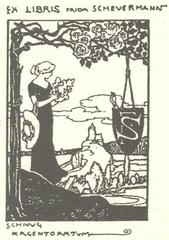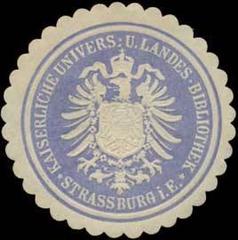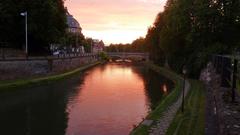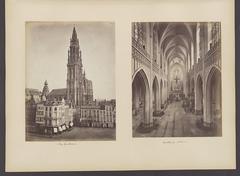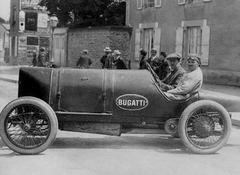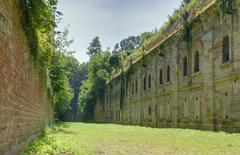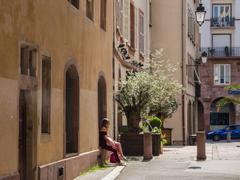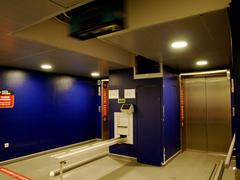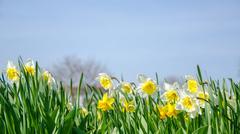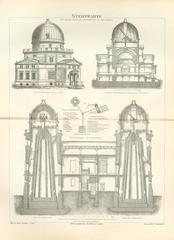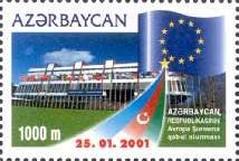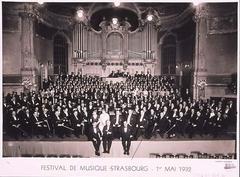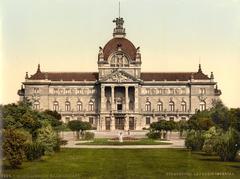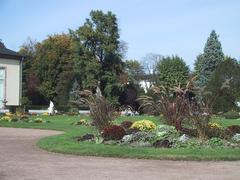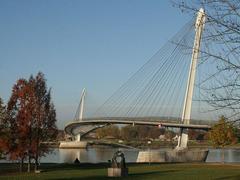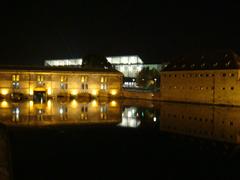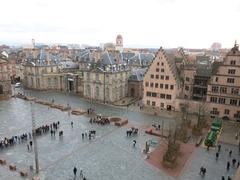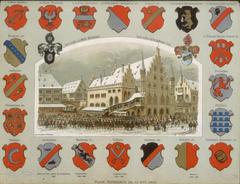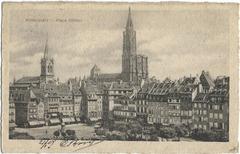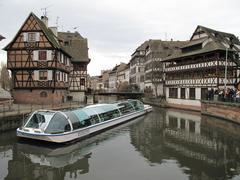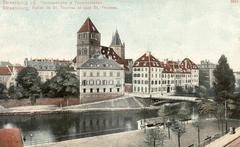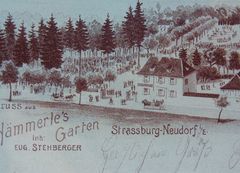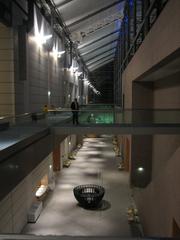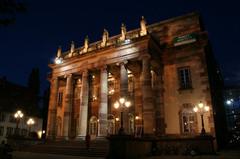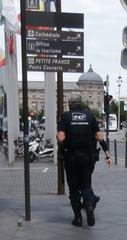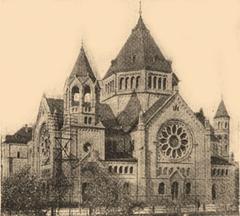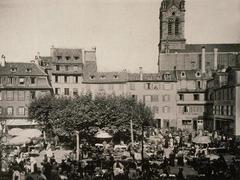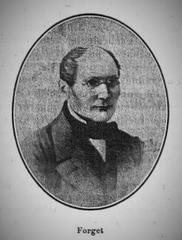Saint-Pierre-Le-Jeune Protestant Church: Visiting Hours, Tickets, and Historical Significance in Strasbourg
Date: 15/06/2025
Introduction
In the heart of Strasbourg, the Saint-Pierre-Le-Jeune Protestant Church stands as a testament to nearly a millennium of religious and architectural history. From its early Merovingian foundations to its Romanesque and Gothic grandeur, and its unique role during the Reformation and Simultaneum period, this church is one of Strasbourg’s most treasured landmarks. This comprehensive guide details the church’s rich past, architectural highlights, practical visitor information, and tips for making your visit memorable (visitstrasbourg.fr; Strasbourg Pratique; Spotting History).
Table of Contents
- Introduction
- Early Foundations and Romanesque Origins
- Medieval Expansion and Gothic Transformation
- Reformation and the Simultaneum
- Architectural Highlights & Artistic Heritage
- Visiting Saint-Pierre-Le-Jeune: Hours, Tickets, and Accessibility
- Guided Tours, Events, and Concerts
- Travel Tips and Nearby Attractions
- FAQs
- Plan Your Visit and Stay Connected
- References
Early Foundations and Romanesque Origins
The site of Saint-Pierre-Le-Jeune Protestant Church has been a spiritual center since the 7th century, when a Merovingian chapel and pilgrim hostel were established. The current Romanesque church began construction in 1031 and was consecrated in 1053 by Pope Leo IX, an Alsatian native. Remnants from this period, including the base of the bell tower and parts of the original walls, are still visible today (visitstrasbourg.fr; fr.wikipedia.org).
One of the church’s most distinctive features is its Romanesque cloister, with three galleries dating from the 11th century and a fourth from the 14th. This cloister is the oldest preserved north of the Alps, offering a rare glimpse into medieval monastic life (visitstrasbourg.fr).
Medieval Expansion and Gothic Transformation
The 13th and 14th centuries saw extensive Gothic-style expansion. The soaring nave, ribbed vaults, and pointed arches exemplify the era’s architectural innovations. The church’s transformation was completed by 1320, and the interior became adorned with frescoes depicting biblical scenes and saints—many of which have been carefully preserved (Strasbourg Pratique).
The choir screen (jubé), a rare medieval structure in Alsace, separates the nave from the choir and is adorned with intricate carvings. The church also features a replica of Giotto’s “Navicella” and a notable collection of memorial slabs, each telling the story of Strasbourg’s past citizens.
Reformation and the Simultaneum
Saint-Pierre-Le-Jeune became Lutheran in 1524, following Strasbourg’s adoption of the Reformation under Wolfgang Capiton. After the French annexation in 1681, the church entered a unique Simultaneum period: the nave served as a Lutheran sanctuary while the choir was reserved for Catholics, divided by a physical wall. This arrangement lasted nearly 200 years, symbolizing religious coexistence and compromise (fr.wikipedia.org; de.wikipedia.org). The wall was only removed in 1898 when the Catholic parish moved to a new building, and the church was fully restored for Protestant worship (museeprotestant.org).
Architectural Highlights & Artistic Heritage
- Romanesque and Gothic Features: The blending of Romanesque foundations with Gothic nave and choir creates a unique architectural palimpsest.
- Cloister: The tranquil Romanesque cloister is one of Strasbourg’s most atmospheric spaces, ideal for peaceful contemplation and photography (Visit Alsace).
- Frescoes and Art: Vivid 14th-century murals and a rare rood screen are major artistic highlights (Spotting History).
- Organ Heritage: The church was once home to a Silbermann organ (1762), now relocated but replaced by the distinguished Roethinger organ. Concerts and recitals continue the church’s musical tradition.
Visiting Saint-Pierre-Le-Jeune: Hours, Tickets, and Accessibility
- Visiting Hours: Generally open Monday through Saturday from 9:00 AM to 5:00 PM, and Sundays from 12:00 PM to 5:00 PM. Hours may vary on holidays or for special events; always check the official website for updates.
- Tickets & Entrance: Admission is free for worship and self-guided visits. Guided tours and special exhibitions may require a ticket (typically around 5 euros).
- Accessibility: Ramps and adapted facilities make the church accessible for visitors with reduced mobility. Some older areas, such as the crypt, may have limited access.
- Photography: Permitted without flash. Please be respectful, especially during services.
Guided Tours, Events, and Concerts
Guided tours are available regularly in multiple languages, offering deeper insight into the church’s history, architecture, and art. The church also hosts a vibrant program of concerts, particularly organ recitals, as well as religious and cultural events. Event schedules are posted on the official website.
Travel Tips and Nearby Attractions
- Central Location: The church is at Place Saint-Pierre-le-Jeune, a short walk from Strasbourg Cathedral, La Petite France, and the Palais Rohan (Wide World Trips).
- Transportation: Easily accessible by tram and bus.
- Dining: Many nearby restaurants serve traditional Alsatian cuisine.
- Optimal Visiting Times: Mornings or late afternoons are quieter and ideal for photography.
FAQs
Q: What are the visiting hours?
A: Monday–Saturday 9:00 AM–5:00 PM; Sunday 12:00 PM–5:00 PM. Check the official website for updates.
Q: Is there an entrance fee?
A: Entry is free; small fees may apply for guided tours or exhibitions.
Q: Are guided tours available?
A: Yes, offered in multiple languages. Book ahead for group visits.
Q: Is the church accessible for visitors with disabilities?
A: Yes, with ramps and adapted facilities (some older areas may have steps).
Q: Can I take photographs?
A: Yes, without flash; please be discreet and respectful.
Plan Your Visit and Stay Connected
For up-to-date visiting information, ticketing, and event schedules, consult the official church website. Download the Audiala app for self-guided audio tours and follow the church’s social media channels for restoration news and upcoming events.
Enhance your Strasbourg experience by exploring more regional historical sites—combine your visit with a walking tour of the historic center and nearby landmarks.
Visuals and Interactive Elements
Suggested images:
- Exterior view of the Romanesque bell tower and Gothic nave (alt: “Saint-Pierre-Le-Jeune Protestant Church exterior, Strasbourg”)
- Interior showing 14th-century frescoes and the rare rood screen (alt: “14th-century frescoes and choir screen at Saint-Pierre-Le-Jeune Church”)
- The atmospheric Romanesque cloister (alt: “Romanesque cloister columns at Saint-Pierre-Le-Jeune”)
- Map of Strasbourg’s historic center with the church’s location
Interactive resources:
References
- Visit Strasbourg – Saint-Pierre-Le-Jeune: A Well-Hidden Treasure
- Strasbourg Pratique – Guide Découverte de l’Église Protestante Saint-Pierre-le-Jeune
- Musée Protestant – Saint-Pierre-le-Jeune
- Spotting History – Saint-Pierre-Le-Jeune Protestant Church
- Visit Alsace – The Protestant Church Saint-Pierre-le-Jeune
- France Voyage – Church of Saint-Pierre-le-Jeune
- Wikipedia (fr)
- Wikipedia (de)
Saint-Pierre-Le-Jeune Protestant Church is a living chronicle of Strasbourg’s layered heritage, uniquely blending Romanesque foundations, Gothic splendor, and Protestant tradition. Its medieval cloister, vibrant frescoes, rare choir screen, and ongoing musical legacy make it a must-see for anyone interested in history, art, or spirituality. Plan your visit, enjoy the culture, and immerse yourself in this Alsatian treasure.
